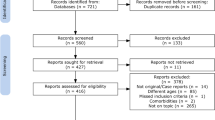Abstract
Neuroimaging studies of rare disorders, such as dyslexia, require long term, multi-centre data collection in order to create representative disease specific cohorts. However, multi-site data have inherent heterogeneity caused by site specific acquisition protocols, scanner setup, etc. The aim of this study was the analysis of the influence of the two confounding factors: site location and field strength on feature selection procedure. We propose two methods: site-dependent whitening and site-dependent extension and compare with naive approach using classification accuracy as a quality measure of selected features subset. The proposed methods outperform the naive approach, and significantly improves the classification performance of developmental dyslexia.
Access this chapter
Tax calculation will be finalised at checkout
Purchases are for personal use only
Preview
Unable to display preview. Download preview PDF.
Similar content being viewed by others
References
Abdulkadir, A., Mortamet, B., Vemuri, P., Jack Jr., C.R., Krueger, G., Klöppel, S.: Effects of hardware heterogeneity on the performance of SVM alzheimer’s disease classifier. NeuroImage 58(3), 785–792 (2011)
Altarelli, I., Monzalvo, K., Iannuzzi, S., Fluss, J., Billard, C., Ramus, F., Dehaene-Lambertz, G.: A functionally guided approach to the morphometry of occipitotemporal regions in developmental dyslexia: Evidence for differential effects in boys and girls. The Journal of Neuroscience 33(27), 11296–11301 (2013), PMID: 23825432
Ashburner, J., Friston, K.J.: Voxel-based Morphometry—The methods. NeuroImage 11(6), 805–821 (2000)
Desikan, R.S., Ségonne, F., Fischl, B., Quinn, B.T., Dickerson, B.C., Blacker, D., Buckner, R.L., Dale, A.M., Maguire, R.P., Hyman, B.T.: An automated labeling system for subdividing the human cerebral cortex on MRI scans into gyral based regions of interest. Neuroimage 31(3), 968–980 (2006)
Han, X., Jovicich, J., Salat, D., van der Kouwe, A., Quinn, B., Czanner, S., Busa, E., Pacheco, J., Albert, M., Killiany, R., Maguire, P., Rosas, D., Makris, N., Dale, A., Dickerson, B., Fischl, B.: Reliability of MRI-derived measurements of human cerebral cortical thickness: The effects of field strength, scanner upgrade and manufacturer. NeuroImage 32(1), 180–194 (2006)
Hastie, T., Tibshirani, R., Friedman, J., Hastie, T., Friedman, J., Tibshirani, R.: The elements of statistical learning, vol. 2. Springer (2009)
Hoeft, F., McCandliss, B.D., Black, J.M., Gantman, A., Zakerani, N., Hulme, C., Lyytinen, H., Whitfield-Gabrieli, S., Glover, G.H., Reiss, A.L., Gabrieli, J.D.E.: Neural systems predicting long-term outcome in dyslexia. Proceedings of the National Academy of Sciences 108(1), 361–366 (2011), PMID: 21173250
Jednoróg, K., Gawron, N., Marchewka, A., Heim, S., Grabowska, A.: Cognitive subtypes of dyslexia are characterized by distinct patterns of grey matter volume. Brain Structure and Function, 1–11
Jednoróg, K., Marchewka, A., Altarelli, I., Monzalvo, K., van Ermingen-Marbach, M., Grande, M., Grabowska, A., Heim, S., Ramus, F.: How reliable are grey matter disruptions in developmental dyslexia? insights from a large-scale voxel-based morphometry study
Kuperberg, G.R., Broome, M., McGuire, P.K., David, A.S., Eddy, M., Ozawa, F., Goff, D., West, W.C., Williams, S.C.R., van der Kouwe, A., Salat, D., Dale, A., Fischl, B.: Regionally localized thinning of the cerebral cortex in schizophrenia. Archives of General Psychiatry 60, 878–888 (2003)
Marchewka, A., Kherif, F., Krueger, G., Grabowska, A., Frackowiak, R., Draganski, B.: Influence of magnetic field strength and image registration strategy on voxel-based morphometry in a study of alzheimer’s disease. Human Brain Mapping (2013)
Monzalvo, K., Fluss, J., Billard, C., Dehaene, S., Dehaene-Lambertz, G.: Cortical networks for vision and language in dyslexic and normal children of variable socio-economic status. NeuroImage 61(1), 258–274 (2012)
Pernet, C.R., Poline, J.B., Demonet, J.F., Rousselet, G.A.: Brain classification reveals the right cerebellum as the best biomarker of dyslexia. BMC Neuroscience 10(1), 67 (2009), PMID: 19555471
Reuter, M., Rosas, H.D., Fischl, B.: Highly accurate inverse consistent registration: A robust approach. NeuroImage 53(4), 1181–1196 (2010)
Reuter, M., Schmansky, N.J., Rosas, H.D., Fischl, B.: Within-subject template estimation for unbiased longitudinal image analysis. NeuroImage 61(4), 1402–1418 (2012)
Rosas, H.D., Liu, A.K., Hersch, S., Glessner, M., Ferrante, R.J., Salat, D.H., van der Kouwe, A., Jenkins, B.G., Dale, A.M., Fischl, B.: Regional and progressive thinning of the cortical ribbon in huntington’s disease. Neurology 58(5), 695–701 (2002)
Salat, D., Buckner, R.L., Snyder, A.Z., Greve, D.N., Desikan, R.S., Busa, E., Morris, J.C., Dale, A., Fischl, B.: Thinning of the cerebral cortex in aging. Cerebral Cortex 14, 721–730 (2004)
Stonnington, C.M., Tan, G., Klöppel, S., Chu, C., Draganski, B., Jack Jr., C.R., Chen, K., Ashburner, J., Frackowiak, R.S.J.: Interpreting scan data acquired from multiple scanners: A study with alzheimer’s disease. NeuroImage 39(3), 1180–1185 (2008)
Author information
Authors and Affiliations
Editor information
Editors and Affiliations
Rights and permissions
Copyright information
© 2014 Springer International Publishing Switzerland
About this paper
Cite this paper
Płoński, P., Gradkowski, W., Marchewka, A., Jednoróg, K., Bogorodzki, P. (2014). Dealing with the Heterogeneous Multi-site Neuroimaging Data Sets: A Discrimination Study of Children Dyslexia. In: Ślȩzak, D., Tan, AH., Peters, J.F., Schwabe, L. (eds) Brain Informatics and Health. BIH 2014. Lecture Notes in Computer Science(), vol 8609. Springer, Cham. https://doi.org/10.1007/978-3-319-09891-3_43
Download citation
DOI: https://doi.org/10.1007/978-3-319-09891-3_43
Publisher Name: Springer, Cham
Print ISBN: 978-3-319-09890-6
Online ISBN: 978-3-319-09891-3
eBook Packages: Computer ScienceComputer Science (R0)




